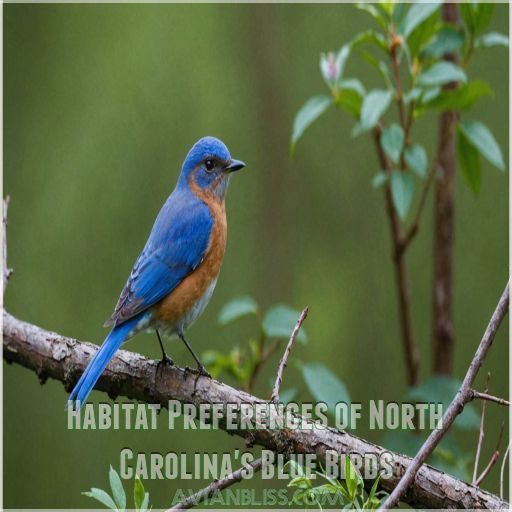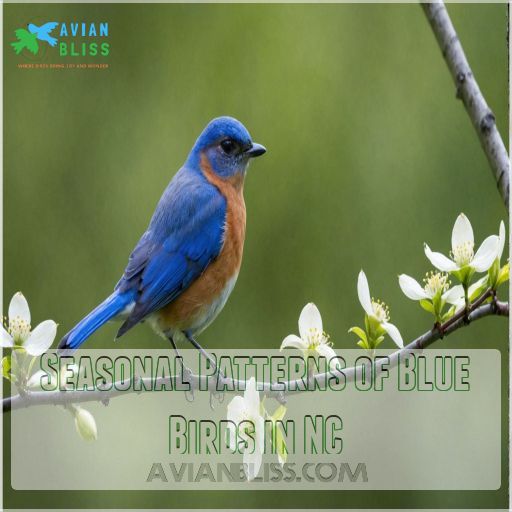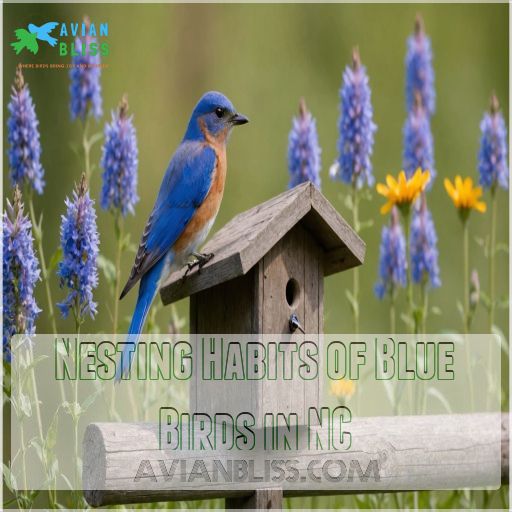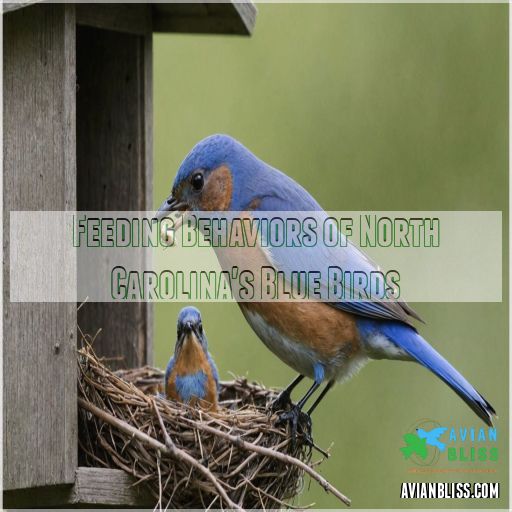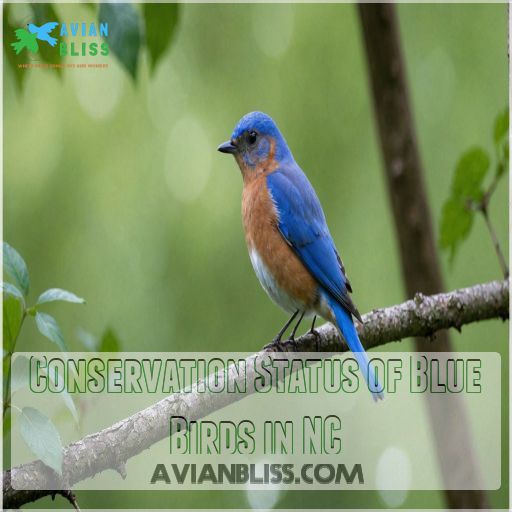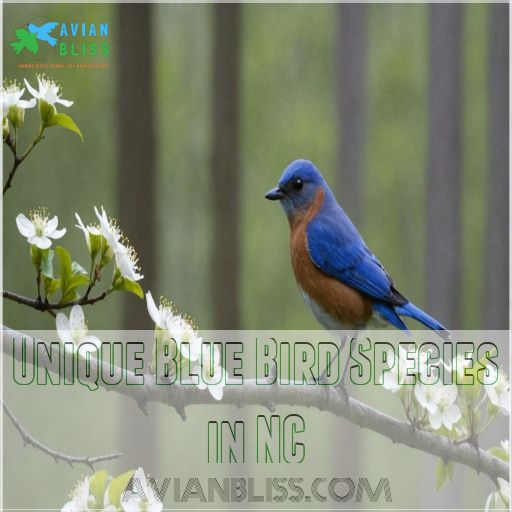This site is supported by our readers. We may earn a commission, at no cost to you, if you purchase through links.

You’ll find the striking Eastern Bluebird with its sky-blue back and rusty breast flitting about in open woodlands and gardens. The bold Blue Jay, always ready to steal the show with its loud calls and vibrant blue plumage, is a year-round scene-stealer.
Meanwhile, summer brings the splendid Indigo Bunting and its larger cousin, the Blue Grosbeak, their deep blues adding to the avian palette.
Whether perching on a fence post or zipping through trees, these birds add a touch of wild freedom to everyday life. Who knew birdwatching could be so blue-tifully colorful?
Table Of Contents
- Key Takeaways
- Common Blue Birds in North Carolina
- Identifying Blue Birds by Appearance and Behavior
- Habitat Preferences of North Carolina’s Blue Birds
- Seasonal Patterns of Blue Birds in NC
- Nesting Habits of Blue Birds in NC
- Feeding Behaviors of North Carolina’s Blue Birds
- Conservation Status of Blue Birds in NC
- Photographing Blue Birds in North Carolina
- Blue Birds in North Carolina’s Culture
- Unique Blue Bird Species in NC
- Frequently Asked Questions (FAQs)
- What kind of blue birds are in NC?
- Do bluebirds stay year-round in North Carolina?
- When to clean out bluebird houses in North Carolina?
- Does North Carolina have blue jays?
- How do blue birds communicate with each other?
- What diseases affect blue bird populations in NC?
- Are there any blue bird sanctuaries in NC?
- How do local ecosystems benefit from blue birds?
- What is the migration impact on NCs blue birds?
- Conclusion
Key Takeaways
- You’ll spot a variety of blue birds in North Carolina, like the bold Blue Jay with its sharp mimicry skills, or the gentle Eastern Bluebird, which adds charm to your backyard. During summer, look out for the vibrant Indigo Bunting and Blue Grosbeak, both of which turn landscapes into a colorful canvas.
- Blue birds are nature’s architects; they choose nests in tree cavities or in artificial boxes, crafting cozy spots with grasses. If you’re playing landlord, set up a nest box early in the year and enjoy a front-row seat to their nesting rituals.
- These blue beauties are year-round companions with versatile diets; they switch between insects and seeds based on the season. Want them in your garden? Offer mealworms and keep feeders in sunny spots, away from pesticide-treated areas.
- The conservation of blue birds is crucial. Habitat loss and climate change challenge them, yet there’s hope in efforts like setting up birdhouses and protecting breeding areas. See them as tiny pest controllers, helping gardens and crops flourish.
Common Blue Birds in North Carolina
You’ll find a dazzling array of blue-feathered friends in North Carolina, from the noisy Blue Jay to the beloved Eastern Bluebird, which thrives in Michigan bluebird habitats
.
These birds include the brilliant Indigo Bunting or the striking Blue Grosbeak, which will add a splash of color to your birdwatching adventures.
Blue Jay: Vibrant and Noisy Resident
You’ll spot the blue jay’s vibrant feathers and hear its raucous calls year-round in North Carolina. These intelligent birds are masters of mimicry, often imitating hawks to scare off competitors. Their blue feathers appear blue due to light scattering, not pigment, giving them a unique appearance. They also demonstrate impressive problem-solving skills, such as using twigs or newspaper strips to snatch treats, showcasing their tool use.
Here’s what to look for:
- Bright blue plumage with a distinctive crest
- Bold black necklace and white wingbar
- Acrobatic flight patterns as they swoop between trees
Blue jays thrive in forest edges and woodlots, building well-hidden nests of twigs. They’re not picky eaters, enjoying seeds, nuts, and insects alike.
Eastern Bluebird: Beloved Backyard Visitor
While Blue Jays make a ruckus, Eastern Bluebirds bring a gentle charm to your backyard. These sky-blue beauties, with rusty breasts and white bellies, are a sight for sore eyes.
They’re year-round residents in North Carolina, so you can enjoy their company anytime.
Want to attract these feathered friends? Put up a nest box by early February, and you might just score some bluebird tenants come spring.
Indigo Bunting: Brilliant Summer Migrant
After the Eastern Bluebird’s year-round charm, let’s turn our attention to a stunning summer visitor. The Indigo Bunting arrives in North Carolina like a splash of vibrant sky, bringing its brilliant blue plumage and cheerful song. These "blue canaries" fill brushy fields and woodland edges with their bouncy tunes from dawn to dusk.
- Males sport dazzling blue feathers that shimmer in the sunlight
- Females wear a more subtle brown plumage for camouflage
- Their song is a rapid, excited warble with repeated phrases
- Look for them perched on telephone wires or treetops, singing their hearts out
Blue Grosbeak: Large and Striking Songbird
The Blue Grosbeak, a larger cousin of the Indigo Bunting, turns heads with its striking deep blue plumage and chestnut wing bars.
You’ll often spot these beauties perched on fence lines, surveying their territory and chasing potential mates.
Like their Cardinal relatives, they’ve got a powerful beak for cracking seeds, but they’ll switch to juicy grasshoppers during breeding season to feed their chicks.
Keep your eyes peeled for these stunning songbirds during the breeding season!
Identifying Blue Birds by Appearance and Behavior
You’ll become a true blue bird detective with these tips on identifying our feathered friends by their looks and quirks.
From the flashy blue jay’s mohawk to the eastern bluebird’s cheerful warble, you’ll soon be spotting these azure beauties like a pro.
Size and Shape Variations
Now that you’re familiar with North Carolina’s blue birds, let’s size ’em up!
From the tiny blue-gray gnatcatcher to the hefty birds with vibrant blue feathers, these feathered friends come in all shapes and sizes birds with vibrant blue feathers
.
You’ll notice wingspan differences ranging from 6 to 13 inches, and tail feather lengths that vary widely.
Beak shapes tell a story too – from the tree swallow’s short, wide bill to the blue-headed vireo’s hooked tip.
It’s like nature’s own puzzle, waiting for you to piece it together!
Distinctive Plumage Patterns
Beneath the Carolina sky, you’ll spot a dazzling array of blue-feathered friends. Each species boasts its own unique plumage, like nature’s paintbrush at work.
Let’s explore these winged wonders:
- Eastern bluebirds showcase a brilliant blue back with a rusty breast
- Indigo buntings dazzle with their all-over electric blue hue
- Blue grosbeaks sport a deep blue coat with rusty wing bars
These feathered fashionistas are sure to catch your eye and brighten your day!
Unique Flight Characteristics
When you’re out bird watching, keep an eye on those blue beauties soaring through the sky.
You’ll spot Eastern Bluebirds gliding gracefully from perch to perch, often hovering briefly before diving for insects. Their flight is smooth and direct, with quick wingbeats followed by short glides.
During migration, they’ll cover impressive distances, following their bird range map across North Carolina’s diverse habitats.
Watch for their distinctive flapping pattern – it’s like they’re dancing on air!
Vocalizations and Calls
Listen up, birders! You’ve seen their aerial acrobatics, but have you heard their sweet melodies?
Blue birds are nature’s little songsters, each with its own unique voice. From the cheerful "cheer-lee" of the Eastern Bluebird to the harsh "jay-jay" of the Blue Jay, these calls are like fingerprints in the air.
You’ll soon be identifying birds by ear, feeling like you’re part of their secret avian world, and you’ll be able to distinguish their calls with ease, making you feel like you’re experiencing the aerial acrobatics in a whole new way.
Habitat Preferences of North Carolina’s Blue Birds
You’ll find North Carolina’s blue birds in a variety of habitats, from open prairies Eastern Bluebird habitats to suburban gardens
.
These feathered friends adapt to different environments, so you might spot a Blue Jay in your backyard or an Indigo Bunting in an open field, showcasing their ability to thrive in various settings as feathered friends.
Forest Edges and Open Woodlands
Out on the edge of North Carolina’s forests, you’ll find a bustling bird buffet, often in fire-maintained habitats with low tree density, where Eastern Bluebirds thrive. These woodland fringes are prime real estate for blue birds, offering the best of both worlds, with edge habitats providing biodiversity hotspots, food abundance, breeding and nesting sites, and ecological connectivity, found in eastern bluebird habitat.
You’ll spot Eastern Bluebirds perched on fence posts, scanning open fields for tasty insects. Meanwhile, in the understory, Blue Jays might be calling dibs on prime nesting spots.
It’s like a feathered soap opera, complete with territorial disputes and romantic rendezvous!
Suburban Gardens and Parks
You don’t need to venture far to spot beautiful blue birds in North Carolina.
Your own backyard or local park can be a bluebird paradise! These charming creatures love open spaces with scattered trees, making suburban areas perfect habitats.
Want to attract more bluebirds? Try setting up birdhouses and feeders. Just be sure to place them away from dense woods to avoid competition from house wrens.
With a little effort, you’ll have a front-row seat to nature’s blue-feathered show!
Wetlands and Coastal Areas
Ever wondered where blue birds hang out when they’re not in your backyard?
North Carolina’s wetlands and coastal areas are bustling with avian activity! From great blue herons wading in shallow waters to migrating snow geese taking a pit stop, these diverse habitats are like all-inclusive resorts for our feathered friends.
Coastal marshes serve as essential nurseries for fish and shellfish, creating a buffet for hungry birds. It’s a blue bird paradise!
Agricultural Fields and Grasslands
Across the patchwork of North Carolina’s farmlands, you’ll spot blue birds bringing life to open fields.
Eastern Bluebirds love perching on fence posts, scanning for insects in agricultural areas . They’re not picky eaters, munching on seeds, bugs, and fruits.
This flexible diet helps them thrive year-round, even when winter hits.
Want to help? Put out some suet – it’s a bluebird’s favorite snack!
Seasonal Patterns of Blue Birds in NC
You’ll spot a colorful cast of blue birds in North Carolina as the seasons change, from year-round residents to summer visitors and winter migrants.
Whether you’re watching Blue Jays, known to fiercely defend their territory and cache food like squirrels, you can attract blue jays to your yard by offering them peanuts and sunflower seeds, the favorite foods of these social birds with a wild side. Whether you’re watching Blue Jays boss the feeder in January or Indigo Buntings light up a June morning, the Tar Heel State’s blue birds keep birdwatchers on their toes all year long.
Year-round Residents
North Carolina’s blue bird scene isn’t just a summer fling – some feathered friends stick around all year!
The Eastern Bluebird, a local favorite, calls the Tar Heel State home 365 days a year.
These azure beauties start house-hunting as early as late February, so if you’re thinking of playing landlord, get those nest boxes up by January.
It’s like they’re saying, "Home sweet Carolina, why vacation elsewhere?" The phrase also highlights the year-round presence of the Eastern Bluebird.
Summer Breeding Visitors
Summer in North Carolina brings a flurry of blue-feathered visitors.
You’ll spot Indigo Buntings, their brilliant plumage a stark contrast against green foliage.
These seasonal guests face unique challenges, from fierce nesting site competition to the constant threat of predators.
While they’re here, they’ll work tirelessly to raise their young, dealing with food availability issues and working hard to boost nestling survival rates.
It’s a busy time, but boy, is it beautiful!
Winter Migrants
As winter’s chill sets in, you’ll notice a feathered changing of the guard in North Carolina. Some blue birds tough it out, while others jet off to warmer climes.
Here’s what you’ll see:
- Northern bluebirds join local residents, forming flocks that roam for berries
- Dark-eyed Juncos and White-throated Sparrows arrive, adding splashes of blue-gray
- Common Terns make pit stops along the coast during their journey south
Bundle up and enjoy the winter bird ballet!
Rare and Occasional Blue Bird Sightings
Keeping your eyes peeled for rare blue birds in North Carolina can feel like a treasure hunt.
You might spot a Cerulean Warbler, a true blue gem, during its brief migration stopover.
Climate Watch, a citizen science project, needs your help tracking these elusive beauties.
Don’t be blue if you miss them – habitat shifts and changing migration patterns mean you’ll need patience and a bit of luck to catch these feathered rarities!
Nesting Habits of Blue Birds in NC
You’re in for a treat as we explore the cozy homes of North Carolina’s blue birds, from natural nooks to backyard boxes.
Whether you’re a curious bird enthusiast or a casual observer, you’ll discover how these feathered architects create their nests.
And when they set up shop for the breeding season.
Natural Nest Sites
Now that you know when to spot these beautiful birds, let’s talk nests! Blue birds are nature’s little architects. They’ve got a knack for finding cozy spots in tree cavities, often picking old woodpecker holes in dead pines or oaks, which can provide the ideal blend of hunting grounds and nesting opportunities Eastern Bluebird Habitat Preferences.
They also tend to favor open or semi-open areas with a mix of grassy spaces and nearby woods, where they can utilize their "perch-and-pounce" technique to hunt insects.
These feathered homeowners prefer their digs up to 50 feet off the ground, safe from nosy neighbors. It’s like they’re playing a high-stakes game of "tree house"!
Artificial Nesting Boxes
Many bluebird enthusiasts have found a perfect home-away-from-home for their feathered friends: artificial nest boxes.
These cozy abodes come in various types, from snug 4-inch squares to roomier 6-inch models.
When placing your bluebird B&B, aim for open spaces like farms or suburban lawns.
Use materials like pine or oak, and remember to maintain your avian apartments regularly.
With proper care, you’ll be the talk of the bluebird town, boosting nesting success rates!
Breeding Season Timing
The rhythm of bluebird breeding in North Carolina is a fascinating dance of nature. You’ll notice these feathered friends start their nesting season as early as February. Here’s what you can expect:
- Nest site scouting begins in late February or early March
- Egg-laying kicks off in April, with one egg laid daily
- Incubation lasts about 17-18 days
- Chicks fledge after two weeks in the nest
With up to three broods per season, you’ll have plenty of chances to witness this miracle of life.
Nest Construction and Materials
Blue birds in North Carolina are master architects when it comes to nest construction.
You’ll find their cozy homes tucked away in tree cavities or nestboxes, crafted with care using grasses, pine needles, and sometimes even a bit of mud.
These feathered friends build neat, cup-shaped nests that are just the right size for their brood.
It’s like they’re creating their own little avian condos, perfectly designed for raising the next generation of beautiful blue birds.
Feeding Behaviors of North Carolina’s Blue Birds
You’ll be amazed at the diverse feeding habits of North Carolina’s blue birds, from the acrobatic flycatching of swallows to the seed-cracking prowess of grosbeaks.
Whether you’re watching a Blue Jay cache acorns for winter or an Eastern Bluebird snatch insects mid-flight, you’re in for a treat that’ll make you appreciate these feathered wonders even more.
Natural Diet Preferences
Building a nest requires energy, and that’s where their adaptable diets come into play.
These blue birds are true omnivores, feasting on insects, fruits, and seeds.
Their foraging strategies vary with the seasons, seeking insects in warmer months and berries when it gets colder, ensuring their nutritional needs are met year-round with diverse food sources.
Attracting Blue Birds to Feeders
Imagine your yard filled with vibrant bluebirds by attracting them to feeders. Choose the best feeder types, like ground or platform, and offer insect delicacies such as mealworms rather than seeds. Don’t forget location tips—place feeders in sunny, open spots and avoid pesticide-treated areas.
For extra allure, a bird bath offers cool splashes and irresistible charm.
- Feeder Types: Ground, platform
- Food: Mealworms
- Location Tips: Sunny, open areas
Seasonal Dietary Changes
Attract blue birds with feeders, noting their changing diet through seasons. During winter, when food sources dwindle, they rely heavily on berries for winter survival.
Spring brings an abundance of insects, a welcome change as insect availability thrives. This migration impact helps them be well-fed and ready to build nests.
Creating a delightful balance through the year’s ebbs and flows.
Foraging Techniques and Adaptations
Seasonal changes bring out fascinating foraging strategies in North Carolina’s blue birds.
You’ll notice them pecking at insects or munching on berries.
Ever seen a Blue Jay adapting to feeders, deftly juggling sunflower seeds to match its diverse diet?
Birdseed preferences shift, but they’re always on the lookout for wild fruits too, showcasing nature’s menu flexibility.
Conservation Status of Blue Birds in NC
You might think blue birds in North Carolina have it easy, but their conservation status tells a different story.
With many facing challenges from habitat loss and climate change, it’s clear that their situation is more complicated than initially thought.
Don’t worry too much, though—efforts are ongoing to protect these striking creatures and guarantee their songs continue to brighten our landscapes.
Threatened and Endangered Species
While most blue bird species in North Carolina are doing well, the Cerulean Warbler is considered a threatened species.
This tiny forest-dwelling songbird has seen its population decline by over 70% in recent decades due to habitat loss and fragmentation (Source).
Conservation efforts aim to protect its remaining breeding grounds and migratory corridors.
Habitat Loss and Fragmentation
Imagine a patchwork quilt, but each piece is a natural habitat slowly disappearing.
Habitat loss and fragmentation in North Carolina impact blue birds’ behavior and populations, forcing them to adapt to urban settings, a challenge faced by many species like the Carolina Wren
.
Conservation strategies focus on protecting important bird areas and creating wildlife corridors, giving these stunning species a fighting chance for future generations.
To understand the importance of these conservation efforts, consider the bluebird habitat restoration, which has been instrumental in the species’ recovery in other states.
By restoring native grasses and wildflowers, we can create an inviting habitat for bluebirds, providing them with access to insects, berries, and water.
Climate Change Impacts
You might think climate change is all doom and gloom, but there’s hope for blue birds in North Carolina.
Shifting habitats and migration patterns impact them, but so does your conservation effort!
Consider these factors:
- Blue bird migration patterns in Colorado’s higher elevations changing Mountain Bluebird habitats
.
- Habitat shifts due to rising temperatures.
- Altered breeding patterns.
- Loss of traditional food sources.
- Declining population trends.
Photographing Blue Birds in North Carolina
Photographing blue birds in North Carolina is an adventure that combines patience with the thrill of capturing nature’s vibrant colors.
Grab your camera, head to wetlands or open woodlands, and you’ll likely find these feathery gems sitting pretty—unless, of course, they’re feeling camera shy!
Best Locations for Blue Bird Photography
In North Carolina, uncover hidden gems for bluebird photography. Start at Bluebird sanctuaries like Prairie Ridge Ecostation, go during the prime time near dawn. Chat with local experts who know the best spots.
Here’s a quick guide:
| Location | Best Time | Tips |
|---|---|---|
| Prairie Ridge | Sunrise | Join photo tours |
| Blue Ridge Parkway | Morning | Look for perches |
| Meadowlands | Afternoon | Listen quietly |
Equipment and Techniques
Having found the best spots to photograph blue birds in North Carolina, it’s time to equip yourself for capturing these beauties.
Use quality bird photography gear for sharp images, while binoculars for birding help you spot distant subjects.
Field guides can enhance identification, and setting up bird feeders and nest box installation encourages a closer, more vibrant experience with these stunning creatures.
Seasonal Photography Opportunities
Capturing North Carolina’s bluebirds offers brilliant opportunities year-round. Spring rewards you with vibrant plumage and active nesting. Summer and autumn showcase dynamic migration patterns, promising diverse subjects.
To perfect your shots, consider these tips:
- Use early morning or late afternoon for ideal lighting.
- Incorporate unique composition techniques.
- Target nests in April for engaging photography.
Happy snapping!
Ethical Considerations for Bird Photography
Though you may be tempted to get closer for the perfect shot, always maintain a respectful distance from blue birds to avoid disturbing them.
Use camouflage and stay low to minimize your presence.
When sharing your photos, be transparent about the bird’s circumstances, whether wild or captive. Your ethical approach will inspire others to do the same.
Blue Birds in North Carolina’s Culture
In North Carolina, blue birds aren’t just stunning sights; they also play lively roles in local traditions and culture.
You’ll find these birds celebrated in art and stories, while birdwatching events let you appreciate them up close in the state’s scenic parks.
Symbolism and Folklore
Before snapping a photo, consider the cultural tapestry bluebirds weave. In Native American legends, they’re symbols of hope and renewal, connecting the physical and spiritual worlds with their vibrant color and song.
Whether hinting at happiness or spiritual messages, bluebirds carry a symbolic meaning that enchants anyone curious about their folklore.
Role in Local Art and Literature
In North Carolina, bluebirds don’t just flutter; they inspire.
You’ll find them in local art and literature, symbolizing happiness and hope. Their vivid colors and cheerful songs weave through paintings and poems, much like a morning coffee perk.
Regional folklore embraces their beauty, making these birds icons of cultural impact and creative muse .
Blue Birds in State Parks and Reserves
As bluebirds find their way into local art, you can also spot them in North Carolina’s glorious state parks and reserves.
Focused on bluebird conservation, these havens offer park management keen on habitat restoration, thanks to visitor impact initiatives.
You might stumble upon a ranger-guided birdwatching tour and tap into your inner wildlife guru.
Discover nature’s masterpieces.
Birdwatching Events and Festivals
You’ll love North Carolina’s birdwatching festivals, offering a chance to spot blue birds in their natural habitat.
Attend the Boone Birding Festival or the Wings Over Water Wildlife Festival, where local guides share photography tips and birding hotspots.
Remember your birdwatching etiquette, and enjoy mingling with fellow enthusiasts as you learn about important conservation efforts.
Unique Blue Bird Species in NC
You’re in for a treat with North Carolina’s unique blue bird species, where each one showcases its fascinating traits.
From the elusive Cerulean Warbler to the grand Great Blue Heron, these birds bring a burst of color and excitement to your birdwatching adventures.
Cerulean Warbler: Rare Forest Dweller
Don’t miss the elusive Cerulean Warbler, a rare forest-dwelling blue bird in North Carolina.
This canopy-loving songster sports a striking sky-blue plumage with white and black accents.
Though its numbers have declined, you might spot it flitting high above the treetops, if you’re lucky:
- Breeds in mature, diverse forests
- Defends territory with aerial displays
- Winters in mixed-species flocks in the Andes
- Faces threats from habitat loss and fragmentation
Painted Bunting: Colorful Coastal Visitor
Imagine spotting a painted bunting, a rainbow on wings. This colorful coastal visitor graces North Carolina in summer, favoring coastal habitats threatened by development.
Like the Indigo Bunting, they love snacking on insects during breeding but switch to seeds in other seasons, with a special fondness for thistle seeds.
Their vibrant presence is a result of microscopic nanostructures in their feathers, scattering light to create that dazzling azure hue types of blue birds.
Conservation efforts aim to protect their vibrant presence from habitat threats. Attract them with your feeder filled with plain white millet.
Blue-gray Gnatcatcher: Tiny Insect Hunter
Speaking of vibrant avian wonders, the Blue-gray Gnatcatcher flits into view.
This energetic tiny insect hunter, with its agile flying techniques and quick movements, is known for using mimicry in its diet to snatch insects mid-air.
It nests using spiderwebs and lichens, cleverly camouflaging among branches in North Carolina’s forests! (Source)
Great Blue Heron: Majestic Wading Bird
Spotting a Blue-gray Gnatcatcher buzzing around is delightful, but have you seen the Great Blue Heron?
With its majestic presence and patience, it’s a top contender for North Carolina’s best bird photo.
Living on fish and frogs, their nests high above, these herons show true elegance.
Photographers adore their slow, graceful flight.
Conservation efforts continue.
Frequently Asked Questions (FAQs)
What kind of blue birds are in NC?
Did you know that bluebirds can raise up to three broods per season?
In North Carolina, you’ll find the Eastern Bluebird, a resident bird that stays year-round.
They prefer open habitats like farms and golf courses.
Do bluebirds stay year-round in North Carolina?
You’ll be pleased to know bluebirds remain in North Carolina throughout the year.
They typically search for nesting sites by late February.
Consider setting up your birdhouse before then to welcome these delightful tenants!
When to clean out bluebird houses in North Carolina?
Imagine finding an overstuffed bluebird house in February.
You should clean it out after each brood has fledged, usually from March to August.
This cleaning is essential to prevent pests and prepare for the next breeding season.
Does North Carolina have blue jays?
North Carolina boasts a lively population of blue jays, those clever crested birds with striking blue and white feathers.
You can spot them year-round in forests, parks, and even your backyard, often entertaining with their spirited antics .
How do blue birds communicate with each other?
Bluebirds whisper sweet nothings with melodious songs like “chir wi” or “chur lee,” conveying messages about mating or territorial defense.
They also perform warning dives and display charming dances when chatting about predator threats or neighborhood watch duties, which is part of their neighborhood watch duties.
What diseases affect blue bird populations in NC?
You’re unlikely to spread avian influenza through your backyard blue bird feeder, as songbirds are less likely to contract and transmit the disease, according to the South Carolina backyard birds guidance from the National Wildlife Disease Program
.
Are there any blue bird sanctuaries in NC?
As the saying goes, "where there’s a will, there’s a way,"
and the Eastern Bluebird Rescue Group in Warrenton, NC has certainly proven that adage true.
With over 391,000 bluebird houses built since 1989, they’re leading the charge to restore these beloved birds’ populations.
How do local ecosystems benefit from blue birds?
Local ecosystems gain from blue birds because they control insect populations, protecting crops and gardens.
By feasting on pesky bugs, these birds act like tiny pest control agents, helping maintain balance and boost agricultural productivity.
What is the migration impact on NCs blue birds?
Could migrating blue birds in North Carolina be feeling squeezed by climate change? These charming insect and berry munchers rely on seasons for food.
But don’t worry, initiatives like Lights Out help keep paths clear for safe travels (Source).
Conclusion
Discovering blue birds in North Carolina is like unwrapping a vibrant gift from nature.
Each species brings its own splash of color and charm, from the boisterous Blue Jay to the serene Eastern Bluebird.
As you explore forests and gardens, these winged beauties offer countless opportunities for appreciation and learning.
Whether you’re drawn to their striking plumage or melodious songs, there’s no better time to explore the lives of these stunning species.
Happy birdwatching!



